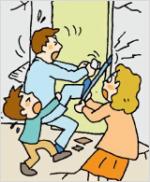An earthquake happens when the seismic waves, which are created by the sudden impact of tectonic forces inside the earth, affect the surface and shake the ground. The direct reason for the occurrence of an earthquake is the movement of the plates. According to the theory of plate tectonics, the earth’s crust is divided into approximately 10 plates (e.g., Eurasian plate and Pacific plate). The plates move as mantle convections, and they are often transformed by the movement which accumulates the kinetic energy within the plates for a long period of time. It builds up the fault zone and an earthquake will occur if the zone cannot hold the stored energy. In other words, land deformation generates an earthquake.
<Earthquakes that Rocked the World>
Since 2000, powerful earthquakes have been occurring all over the world. Among them, the number of earthquakes with over 7.0 magnitude was 246, 8.0 magnitude was 19, and 9.0 magnitude was 2. Around 80% to 90% of earthquakes around the world occurred in the circum-Pacific orogenic belts, which are also known as the “Ring of Fire”. It is active in tectonic activities because it is the boundary line between the Pacific Plate, which is the largest plate on the surface of the earth, and others (e.g., Eurasian Plate and the Indian-Australian Plate). The recent earthquakes in Ecuador and New Zealand happened in the “Ring of Fire”. An earthquake creates direct effects such as ground collapse, tsunami, and damages on roads and bridges. It also creates indirect effects, such as fire, blackout, and communication interruption. It causes death and property damage.
The biggest earthquakes according to the number of deaths in the world after the year 2000
|
Date |
Location |
Deaths |
Magnitude |
|
2010.01.12 |
Haiti |
316000 |
7.0 |
|
2014.12.26 |
Sumatra |
227898 |
9.1 |
|
2008.05.12 |
Eastern Sichuan, China |
87587 |
7.9 |
The biggest earthquakes in the world after the year 2000
|
Date |
Location |
Magnitude |
|
2004.12.26 |
Sumatra |
9.1 |
|
2011.03.11 |
Japan |
9.0 |
|
2010.02.27 |
Chile |
8.8 |
<Earthquakes in Korea>
On the Korean Peninsula, an earthquake with over 2.0 in magnitude frequently occurs approximately 48 times a year on average since the 2000s. An earthquake with a magnitude of over 4.0 occurs once a year around the peninsula. There was also the occurrence of a 5.8-magnitude earthquake that happened in Gyeongju, Gyeongbuk on September 12. It is the highest magnitude since the Korea Meteorological Administration (KMA) officially began the seismic observation in 1978. The vibration of the quake was felt by the people in Seoul, which is far from the epicenter. Historical records, such as the <Samguk Sagi> and <The Annals of the Joseon Dynasty>, listed approximately 1,800 earthquakes, including the huge ones with magnitudes of 6.0 to 7.0, that occurred in the Korean Peninsula since 2 A.D. Therefore, the possibility of a huge earthquake in the future will always exist based on the characteristics of the geological environment around the Korean Peninsula.
Many scientists estimated that the earthquake in Gyeongju on September 12 resulted from the movement of the Yangsan Fault, which is the most renowned active fault in the southeastern part of the Korean peninsula. It was caused by various tectonic phenomena based on the interaction between the Eurasian Plate, the Pacific Plate, and the Philippine Plate after the occurrences of the Great East Japan earthquake and the Kumamoto earthquake. It made the Yangsan fault energetic.
Since the number of earthquakes on the Korean peninsula is fewer than that of the other regions, the data on the geological structures are insufficient, and the observation level is low. Due to the situation, the government was unable to find out the accurate reason for the earthquakes, as well as predict the time and position of future occurrences. There is also a growing confusion because the KMA and the Korean Institute of Geoscience and Mineral Resources (KIGAM) have different means of observation and analysis that can create a huge gap in the measurement of the scale. In addition, the quick response system and seismic provision, including an earthquake-resistant design system, have not been built with certainty, so the peninsula can be damaged when a huge earthquake strikes. If a huge quake hits the southeastern region of Gyeongsang-do, wherein 16 nuclear power plants are located, a lot of people will be in danger of radiation exposure and the nation will suffer from economic damage.
<Tips on How to Evacuate from an Earthquake>
When an earthquake occurred in Gyeongju on September 12, YTN reported that in Korea, where has many concrete buildings and haven’t prepared an earthquake-resistant design system with certainty, people should not stay inside a building, but go out of the building, using stairs. However, according to the education of earthquakes at Boramea Safety Experience Center, the news is wrong, because going outside during an earthquake puts people in danger of falling. Of course, the ways to evacuate are not absolute, but we should follow the best way. If you feel an earthquake, you should follow these evacuation tips.




1. Shout “Earthquake!” and immediately protect your head and body.
2. When the shaking stops, block the gas valve
3. Protect your head and body, and then go outside.
4. Open the door in order to secure an exit.
-What is the first thing to do during an earthquake?
Normally, the vibration of an earthquake ends within 1 minute. In addition, most deaths and injuries during an earthquake resulted from falling. Therefore, when an earthquake strikes, you have to protect your head and body first. When it stops, block the gas valve and electricity, and then move to a safe location.
-Is there a difference between earthquake evacuation tips for high and low floors?



